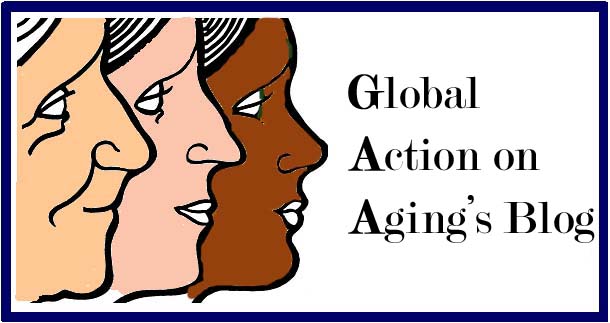
Friday, August 26, 2011
J Edward Shaw Part I

Friday, August 12, 2011
The Graying of AIDS

This week I spoke with Katja Heinemann, Project Director and Visual Journalist, and Naomi Schegloff, Project Co-Director and Writer, of a project called “The Graying of AIDS.” Katja first produced it for Time Magazine in 2006, as both a photo and multimedia essay to draw attention to the aging demographics of people living with HIV and AIDS. Later, many persons wanted to use her essay for educational purposes. An Open Society Institute Documentary Photography Project grant provided the seed funding that allowed Katja to take the Graying of AIDS to the next level. Together with Naomi, they launched a three-pronged campaign designed to increase sensitivity and awareness about the issues confronting people over 50 years at risk for, or living with HIV and AIDS.
Before the “Graying of Aids,” Katja worked on a project about teenagers in the USA who live with HIV. Katja believes that modern treatments lead many to think the epidemic is over and that it’s not a big problem inwealthier countries. Katja wants to show that it is not over. However, many people in the USA do not get treatments for their disease. The stigma associated with the disease is still a huge problem. Katja and Naomi strongly believe that more people need to become more educated about this issue.
“The Graying of AIDS” has found different channels to share their message. The team focuses on informing older adults, their care providers and the general public. A big part of the website draws on stories that older adultstell about their lives with HIV and AIDS. These long time survivors help dispel the knowledge gap in our communities. “The Graying of AIDS”is also a public health project. Experts including older adults living with the virus, care providers, researchers, and activists carefully review the work. Katja and Naomi also collaborate with students from the UNC School of Journalism and Mass Communication and the Art Center College of Design Matters Program creating art and information exhibitions about the Graying of AIDS.

I asked Katja and Naomi about their future goals for “The Graying of AIDS.” The project continues; they add to their website as they go. Katja and Naomi both pointed out the importance of bringing in different perspectives by collaborating across disciplines. Together they offer two perspectives. They recognize that working with people from other fields will have a bigger impact in reducing the stigma and educating people. Their ultimate goal is to co-ordinate care, engage older adults, caregivers and the community to help people connect with each other’s humanity.
Thursday, August 11, 2011
Second Session of the United Nations Open-Ended Working Group on Ageing (August 2011)

However, the great majority of the delegates, NGOs and panelists supported the OEWG and encouraged its continuation. Many seemed to suggest that “Ageing” should be one of the priorities both at national and international level. Also some delegates, such as Switzerland and Canada, and NGOs asked for a Special Rapporteur on the Ageing issue.

I had the chance to hear two great presentations on the situation of older persons in Africa, in different sessions: one about Ghana, the other about Tanzania. Both were really instructive showing problems older Africans face and how their countries try -or not- to solve them. Teresa Minja represented the Tanzania Social Protection Network talked about the shocking cases of persecution older women for “witchcraft” in Africa and, in particular, in her country. Due to traditional beliefs and a confused and unfair inheritance law, older women are sometimes accused of witchcraft and victims of different forms of discrimination (from exclusion and isolation to lynching and killing) as a method to take land “rights” away from widows. Ellen Borkei-Doku Aryeetey represented the University of Ghana tried to evoke all the problems faced by older persons in Africa: income insecurity, competition between young and old persons for scarce resources, lack of interest on the older persons issue in Africa and more.
Himanshu Rath, from the Indian NGO Agewell International, was really interesting as he gave us data and testimonies on the issues older Indians have to face: illiteracy, abuse from family members, in particular, the daughter-in-law, no resources, circumstances that force elders to remain invisible, a gender gap that renders many old women powerless and poverty-stricken. He pointed to these quotations: “Loneliness and the feeling of being unwanted is the most terrible poverty” (Mother Teresa) and “It is good to swim in the waters of tradition, but to sink in them is suicide” (Gandhi). Finally, he urged consideration for a UN Convention to assure the rights of older persons.
Oldrich Stanek, from the Czech organization, Zigo 90, that works with the European Union, gave a clear presentation during the “Age and Social Exclusion of Older Persons” session. He underlined that there were three types of exclusion older persons face: social, financial and from the labor market. He gave proposals to thwart this situation and presented two reports he had made to a member of power in the Czech Republic and European Union and as a guide of civil dialogue.
On the session on “Violence and Abuse against Older Persons,” the first two presentations had no direct link with the subject. Indeed, Claudio Grossman, from the Committee against Torture, just wondered about the need for another Convention while citizens already have the Human Rights Declaration with all the fundamental rights. Then, the presentation by Keren Fitzpatrick, an Asia Pacific Forum member, gave a general overview all the institutions and jurisdictions the Forum embraces.


